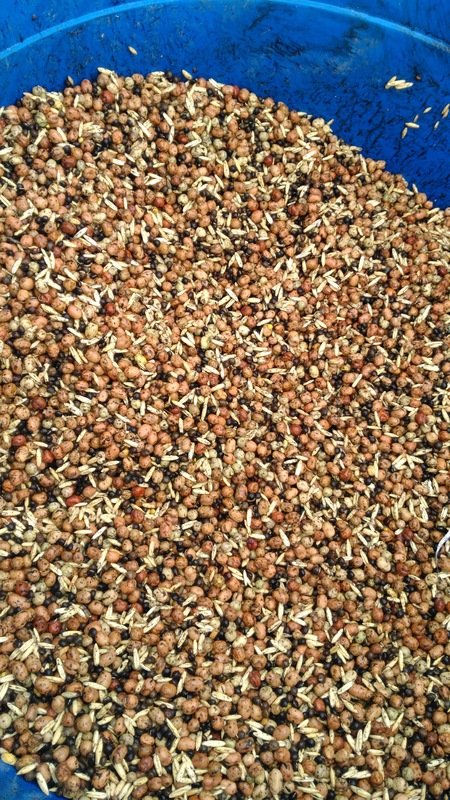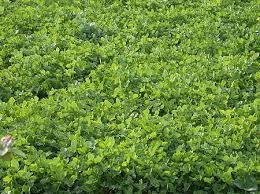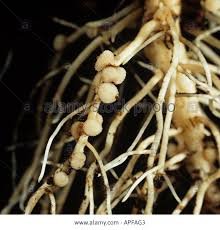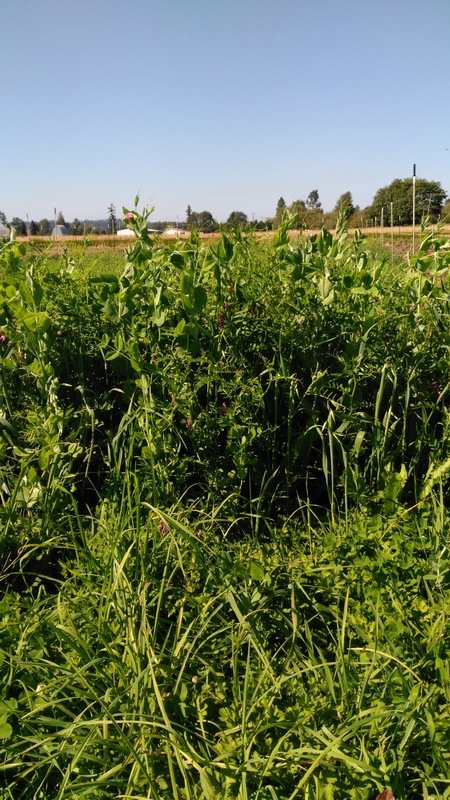A cover crop, or a green manure crop, is a crop planted mainly to manage soil fertility, soil erosion, soil quality, water, weeds, pests, diseases and biodiversity. It does all these things without damaging or polluting the soil, water, food, beneficial insects or the environment.
In this post, we'll look at the many benefits of using cover crops on your farm or garden.
What are cover crops?
Cover crops are of the most important crops you could grow in sustainable farming. They are crops grown prior to a main crop in order to increase the fertility of the soil, suppress weeds, attract beneficial insects while increasing water holding capacity, organic matter, improving soil structure and mining minerals from deep within the soil.
Sounds like magic, right?

A seven seed mix of cover crop seeds planted at the 5 acre food forest project. <==Click this link to read about it
My first experiance with cover crops
The first time I used cover crops was a real eye-opener for me and I have used them ever since without looking back.
I was renting a beautiful, 3-bedroom home on a 17 acre, organic grape farm in Redwood Valley, California. Behind the house was a quarter acre garden that had been abandoned for many years and infested with weeds.
The soil was so compacted that standing with my full weight on a pointed shovel, I could only force the shovel blade into the soil about half the length of the blade, or 5-6 inches deep.Two years later, using cover crops and without ever tilling the soil, I could point the handle of the shovel towards the soil and with my palm on the blade, push the shovel all the way into the soil up to the blade, about 5 feet deep.
The soil was alive with earthworms and the crops grown there were a picture of healthy food, free of nutrient deficiencies or pest infestations, requiring little to no weeding and zero fertilizer applications.
How did cover crops do that?
Plant roots can grow deeper than a rototiller or plow can dig and do so without compacting the soil. By using cover crops, the roots of the crops traveled deep into the soil, loosening the compacted soil so that air, nutrients and water can penetrate deeper into the soil.
When the cover crop dies, the roots die with it and decompose. This decomposed organic matter is food for the soil microorganisms that go to work feeding on it, creating soil fertility and changing the soil structure in the process.
Most of these organisms are not visible to the naked eye but we can see the worms. Earthworms migrate to this "feast" and feed on the organic matter and organisms concentrated there, leaving tunnels in their wake which further aerate the soil allowing more oxygen and water to infiltrate the soil layers, creating a porous, subterranean environment ideal for living soil organisms.
Roots of crops grown following a cover crop can more easily penetrate the soil by growing deeper into the channels created by the decay of the previous cover crop and the passageways made by the worms, but the benefits of cover crops don't stop there.
Cover crops can "fix" nitrogen
Nitrogen fixation is defined as:
Process by which free nitrogen (N2) is extracted from the atmosphere and converted (fixed) into nitrogen compounds which are plant nutrients (fertilizer). In nature, this process is carried out by certain bacteria (present in the root nodules of legumes such as beans and peas), blue-green algae, and the lightning flash.
Leguminous plants like peas and beans can literally harvest atmospheric nitrogen from the air, which contains about 87% nitrogen, and store it deep within the soil layer for later use by subsequent plants growing there. It does this by a symbiotic relationship with nitrogen-fixing organisms or bacteria.
Nitrogen is one of the main nutrients, or macro-nutrients, needed for healthy plant growth and without it plants suffer nutrient deficiencies that can kill the plant.
If you've ever used either chemical or organic fertilizers before, you may have noticed three numbers on the package of fertilizer that reads something like 10-10-10 or 10-5-10 and the numbers represent N-P-K, or nitrogen, phosphorous and potassium. These are the three main nutrients needed by plants to grow.
Through a chemical exchange between the legumes and root-dwelling bacteria, nitrogen is given to the bacteria by the plants in exchange for sugars and carbohydrates created by the bacteria for the plants. Both the plant and the bacteria benefit from this mutual trade.
You can see root nodules growing along the roots of these nitrogen fixing plants, storing nitrogen safely in a plant-available form in the soil.
Root nodules are defined in Wikipedia as:
Root nodules occur on the roots of plants (primarily Fabaceae or legumes) that associate with symbiotic nitrogen-fixing bacteria. Under nitrogen-limiting conditions, capable plants form a symbiotic relationship with a host-specific strain of bacteria known as rhizobia. This process has evolved multiple times within the Fabaceae, as well as in other species found within the Rosid clade.The Fabaceae include legume crops such as beans and peas.
Cutting these nodules open you would see it bleed red like blood.
Nitrogen is highly mobile both in plant tissue and the environment. You may have read or seen examples of nitrogen pollution caused by over fertilization of crops or stockpiling of animal manures. This leads to anaerobic conditions in the soil and water leading to soil unsuitable for plant life and undrinkable water. The excess of nitrogen leaches into the soil profile and eventually into the streams, water table and oceans rendering it tainted.
Unlike chemical nitrogen fertilizer, the nitrogen formed by nitrogen fixation is stable. It's still very mobile within plant tissues and assimilated by plant roots, but not easily washed into the water table by rain or erosion. It's fixed into the soil and mostly freed up by coming into contact with plant roots and absorbed up into the plants where it is most needed and not into our water supply.
Cover cropping multiple years in a row can ween a farmer from having to use any chemical fertilizers at all, ever.
Amazingly, the benefits do not stop there.
Cover crops can reduce or eliminate weeding
Weeds can overcome a garden or crop to the point of crop failure. Weeds not only compete with your intended crops for sunlight and nutrients, they can host pests that can damage your crop, reduce your yields and increase your labor costs.
Weeds are costly to control whether you're growing organically or not. Organic growers incur higher labor costs controlling weeds by hand or machine and conventional farmers use herbicides to kill weeds, increasing their costs to the detriment of the environment.
Cover crops planted before weeds have a chance to emerge in the spring, can grow faster than weeds, eventually smothering them out by growing taller than the weeds and hogging the light. Surviving weeds grow weak and spindly, reducing their chances of setting seed and eventually, over time, vanishing completely.
Once the cover crop dies, it leaves behind a layer of decaying plant residue that hinders weed seeds from being able to germinate. Many of the weed seeds decay to the point that they won't germinate properly and those that manage to poke through this residue layer are not able to do so in time to set seed and are easily removed by hand.
Cover crops reduces pest pressure
Gardeners and farmers know the sinking feeling of spending a season caring for and nurturing a crop only to see it devoured by bugs. Conventional farmers spend ridiculous amounts of money spraying our food with pesticides and poisons, oblivious to how nature handles this problem. The health and environmental implications of using these poisons are mind-boggling to me. What does nature do?
Well, first of all, nature, in stark contrast to industrial agriculture, does not grow monocultures;
Monoculture:
The cultivation of a single crop in a given area
and there's a very good reason for that.
Imagine for a moment you're a bug that likes to eat corn. You're buzzing around in your buggly way when you buzz upon a never-ending field of corn. Everywhere you look; corn, corn, corn. No predators to worry about and a limitless feast of your favorite food. You may think to yourself, "Hey, this is a good place to live and start a family." Before you know it your family grows to a few million children and you're in bug heaven.
From the farmers perspective his field has a bug infestation so it's time to get to spraying pesticides, which kill everything, including the good bugs.
Nature never grows monocultures because there's a better way to control pests and that's with predators.
Beneficial insects are insects that eat other insects and for the most part leave your crops alone. They can control pest populations keeping their numbers in check so you won't have a bug problem, but they need a place to live too. Cover crops provide a home to beneficial insects.
Spraying chemical pesticides kill every bug, both good and bad, and when combined with monoculture, they actually create the problem the farmer is trying to control.
By providing a habitat for beneficial insects, pest pressure is reduced and kept in check as the pests are eaten by the "good" bugs. Once in balance, it is no longer a problem and there's no need to spray pesticides.
Cover crops reduce soil erosion while increasing water absorbtion
The impact of a raindrop on bare soil loosens the soil particles on the surface and can wash the soil away leading to soil erosion and mineral loss.
Cover crops absorb the force of rainfall impact by cushioning energy before it reaches the soil surface. As the raindrop his the plants, the energy falling rain slows down before it hits the surface.
The roots provide channels for water to absorb into the soil before it has a chance to pool on the surface, preventing it from washing the soil away.
The shade to the soil's surface provided by cover crops, prevent the soil surface from drying out and this allows water to infiltrate more as well. Soil organisms can proliferate in the soil surface because of this moistness and the increase of soil organisms on the surface can keep fungi from growing unchecked, leading to a reduction in mold diseases that attack crops.
As moisture evaporates from the soil, it condenses on the leaf surfaces of a cover crop and returns to the soil as water droplets reducing water loss through evaporation. This leads to a reduction in water usage.
Cover crops increase organic matter in the soil
Organic matter is:
Organic matter or organic material, natural organic matter, NOM refers to the large pool of carbon-based compounds found within natural and engineered, terrestrial and aquatic environments. It is matter composed of organic compounds that has come from the remains of organisms such as plants and animals and their waste products in the environment.
Increasing the organic matter of soils leads to many benefits to growing healthy soils and plants, including but not limited to;
Nutrient Supply. Organic matter is a reservoir of nutrients that can be released to the soil. ...
Water-Holding Capacity. ...
Soil Structure Aggregation. ...
Erosion Prevention.
Cover crops play a key role in increasing organic matter in a cost effective way, by growing it on site rather than bringing in costly farm inputs like manure.
Cover crops as a feed source
Cover crops are a great source of nutrition to the soil and all the microorganisms in the food web and they also feed livestock. Chickens, pigs, cows, goats and many other livestock animals, with a few exceptions, love eating cover crops and its really good for them.
This can greatly reduce the cost of raising animals and, in some cases, make or break a farming operation.
As the cost of petrol continues to rise, farmers are looking for ways to reduce inputs that rely on petroleum and seeding cover crops to ofset feed cots is becoming a more viable option.
Cover crops goes mainstream
Extensive studies have been done by major universities and agricultural scientists on the use of cover crops and its benefits and is becoming more mainstream.
One of my favorite documentaries on the subject can be found on YouTube called, Undercover Farmers. These farmers are not organic farmers by any definition and still use herbicides to kill cover crops, but the mere fact that conventional farmers are beginning to see the financial benefits to their use is encouraging.
Their motivations, while more financial than ecological, are a testament to cover crop's usefulness and may lead to a more widespread adoption of these methods of growing.
Here's the documentary for those who would like to learn more.

Watch Under Cover Farmers to learn how three farmers in Stanly County, NC, started using multiple species cover crops and how they were able to realize economic returns on their investment in the first year.
Conclusions
Moving away from the use of pesticides, herbicides and chemical fertilizers is and important transition to more sustainable methods of meeting our food requirements for the future while protecting the environment and reducing costs of food production and the use of cover crops is a step in the right direction.
If you have never used cover crops before, hopefully you'll begin to see the benefits and have learned something here today. If you have used cover crops, please share your experiences with their use in the comments below.
I always believed the largest room in the world is room for improvement and any insight you have on using cover crops are immensely appreciated.




